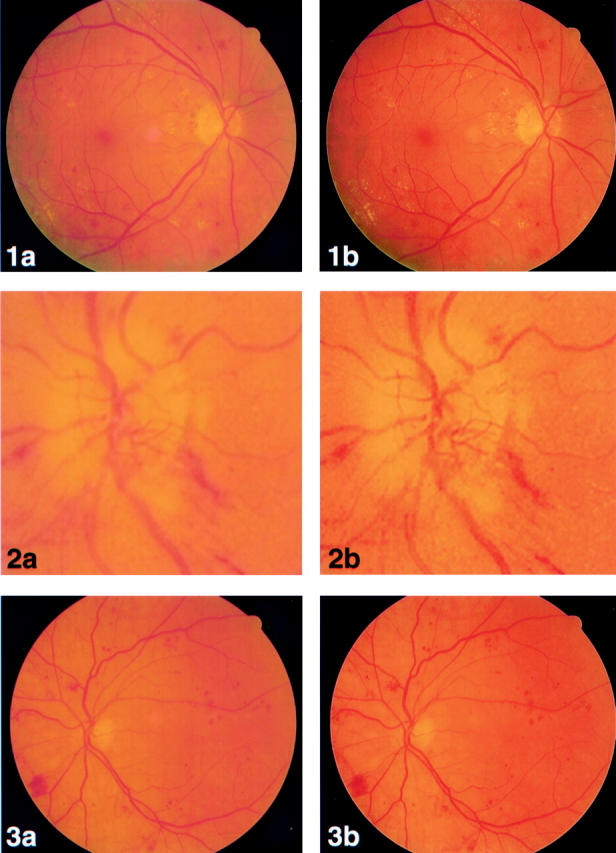Abstract
AIMS—To determine whether software processing of digitised retinal images using a "sharpen" filter improves the ability to grade diabetic retinopathy. METHODS—150 macula centred retinal images were taken as 35 mm colour transparencies representing a spectrum of diabetic retinopathy, digitised, and graded in random order before and after the application of a sharpen filter (Adobe Photoshop). Digital enhancement of contrast and brightness was performed and a X2 digital zoom was utilised. The grades from the unenhanced and enhanced digitised images were compared with the same retinal fields viewed as slides. RESULTS—Overall agreement in retinopathy grade from the digitised images improved from 83.3% (125/150) to 94.0% (141/150) with sight threatening diabetic retinopathy (STDR) correctly identified in 95.5% (84/88) and 98.9% (87/88) of cases when using unenhanced and enhanced images respectively. In total, five images were overgraded and four undergraded from the enhanced images compared with 17 and eight images respectively when using unenhanced images. CONCLUSION—This study demonstrates that the already good agreement in grading performance can be further improved by software manipulation or processing of digitised retinal images.
Full Text
The Full Text of this article is available as a PDF (97.7 KB).

Figures 1-3 Digitised retinal images viewed from within Photoshop. Images 1a, 2a, and 3a have not been digitally enhanced while images 1b, 2b, and 3b have been software enhanced.
Selected References
These references are in PubMed. This may not be the complete list of references from this article.
- George L. D., Halliwell M., Hill R., Aldington S. J., Lusty J., Dunstan F., Owens D. R. A comparison of digital retinal images and 35 mm colour transparencies in detecting and grading diabetic retinopathy. Diabet Med. 1998 Mar;15(3):250–253. doi: 10.1002/(SICI)1096-9136(199803)15:3<250::AID-DIA565>3.0.CO;2-G. [DOI] [PubMed] [Google Scholar]
- George L. D., Leverton C., Young S., Lusty J., Dunstan F. D., Owens D. R. Can digitised colour 35 mm transparencies be used to diagnose diabetic retinopathy? Diabet Med. 1997 Nov;14(11):970–973. doi: 10.1002/(SICI)1096-9136(199711)14:11<970::AID-DIA484>3.0.CO;2-Y. [DOI] [PubMed] [Google Scholar]
- Harding S. P., Broadbent D. M., Neoh C., White M. C., Vora J. Sensitivity and specificity of photography and direct ophthalmoscopy in screening for sight threatening eye disease: the Liverpool Diabetic Eye Study. BMJ. 1995 Oct 28;311(7013):1131–1135. doi: 10.1136/bmj.311.7013.1131. [DOI] [PMC free article] [PubMed] [Google Scholar]
- Lefèbvre P. J., Scheen A. J. The postprandial state and risk of cardiovascular disease. Diabet Med. 1998;15 (Suppl 4):S63–S68. doi: 10.1002/(sici)1096-9136(1998120)15:4+<s63::aid-dia737>3.3.co;2-z. [DOI] [PubMed] [Google Scholar]
- Ryder R. E., Kong N., Bates A. S., Sim J., Welch J., Kritzinger E. E. Instant electronic imaging systems are superior to Polaroid at detecting sight-threatening diabetic retinopathy. Diabet Med. 1998 Mar;15(3):254–258. doi: 10.1002/(SICI)1096-9136(199803)15:3<254::AID-DIA543>3.0.CO;2-C. [DOI] [PubMed] [Google Scholar]


